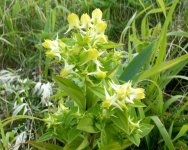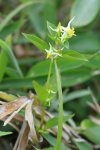Horned - halenia corniculata l.
Family Gentianaceae - Gentianaceae
Botanical characteristics. Annual herbaceous plant up to 50 cm tall. It grows in meadows, forest fringes, in sparse forests and bushes.
The root is simple with numerous subordinate roots. Stalk erect, weakly branched. Leaves opposite to oblong-elliptical, slightly curved, with three expressed veins, pointed at the ends, entire. The flowers are four-membered, the petals white, horn-like, fused only at the base, have small shportsa. Anthers are yellow, high protruding above the corolla. Flowers are collected in pyramidal-paniculate inflorescence. Blossoms in July, bears fruit in August. Fruit - a box, the seeds are numerous, small, smooth, brown.
Used parts of the plant. Medicinal raw materials are all parts of the plant, but more often the aboveground part and flowers. Raw materials are collected during the whole vegetation period of the plant. It is pulled out with a root during flowering and dried in dryers at a temperature of 30-40 ° C or outdoors in the shade. Seeds are harvested as they mature, and are dried outdoors.
Chemical composition. All parts of the plant contain bitterness. The aerial part in addition contains essential oil, xanthones, glycosides: gentiopicrin, gancisin, gentsiamirin; Alkaloids, tannins, polyphenolic compounds, pigments, microelements, vitamins.
Application. In folk medicine galeniya has long been used as a stimulant appetite and a digestive agent.
Decoctions of the aerial part of the plant were used as a sedative for neuroses, angina and other heart diseases.
Polyphenol complex with experimental toxic hepatitis has a pronounced hepatoprotective and antioxidant effect; The aqueous extract in the experiment has protistocidal activity.
In Tibetan medicine, the aerial part of the plant is used for various diseases of the nervous system, gastritis, enterocolitis, jaundice, liver and bile duct diseases, cholecystitis, as an antipyretic, enhancing digestion, choleretic and diuretic, with hypoxia, which is confirmed experimentally.
Fresh plant juice is effective in loss of appetite and as a cholagogue. It is also used to remove pigment spots. Simultaneously inside and outwardly. Flowers in the form of infusions are used for inflammation of the mucous membranes, for rinsing the oral cavity for strengthening the teeth and treating gums.
Seeds are used for impotence.
Preparation
- For broth take 20 g of the aboveground part of the plant, pour 200 ml of boiling water, insist on a boiling water bath for 30 minutes, cool for 10 minutes, without removing from the bath, filter. Take 2 tbsp. Spoon 3-4 times a day after meals.
- For infusion of 25 g of flowers pour 250 ml of boiling water, insist on a boiling water bath for 15 minutes, cool for 25 minutes, filter. Take should be 30 ml 3-5 times a day, regardless of food intake, washed down with a small amount of water (20-25 ml).
- Fresh juice is taken orally and externally at 1:10 dilution inside 1 tbsp. Spoon after eating.
- From seeds, you can make a tincture on 70% alcohol at a rate of 1:10, insist 10-12 days in a dark place, filter and take 50-60 drops per reception 3-4 times a day before meals.




Comments
Commenting on, remember that the content and tone of your message can hurt the feelings of real people, show respect and tolerance to your interlocutors even if you do not share their opinion, your behavior in the conditions of freedom of expression and anonymity provided by the Internet, changes Not only virtual, but also the real world. All comments are hidden from the index, spam is controlled.